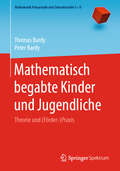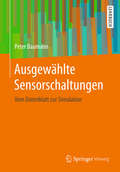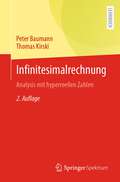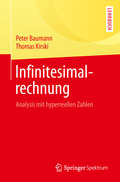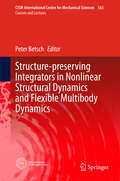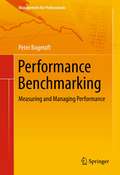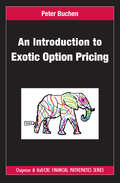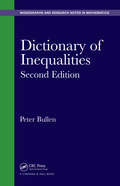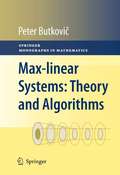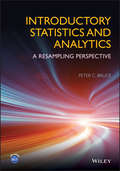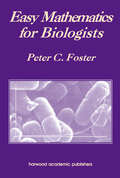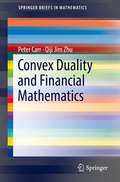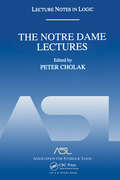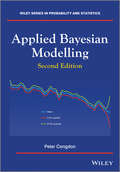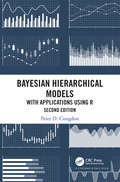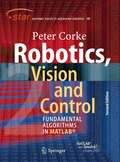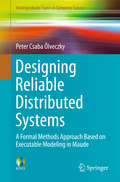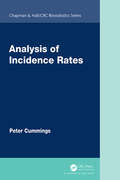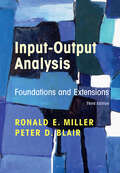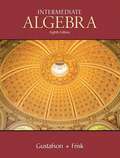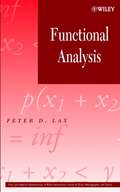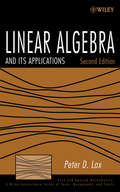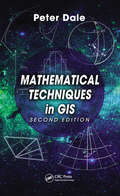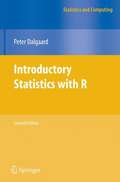- Table View
- List View
Mathematisch begabte Kinder und Jugendliche: Theorie und (Förder-)Praxis (Mathematik Primarstufe und Sekundarstufe I + II)
by Thomas Bardy Peter BardySchon länger ist bekannt, dass auch die Entwicklung begabter Kinder und Jugendlicher nicht von allein verläuft, sondern vielfältiger Unterstützung vor allem durch Elternhaus und Schule bedarf. Die Förderung interessierter und begabter Mädchen und Jungen ist deshalb eine wichtige Aufgabe der Schule vom ersten Schultag an. Dies gilt selbstverständlich auch für die Mathematik. Mit dem geplanten Buch sollen aktuelle theoretische Grundlagen zum Themenkreis „mathematische Begabung“ zur Verfügung gestellt werden. Diese umfassen zunächst eine Einführung in Theorien und Modelle zum (allgemeinen) Begabungsbegriff und Beziehungen zum Konstrukt „Intelligenz“. Schwerpunkt sind Konzepte zum Konstrukt „mathematische Begabung“ in Grundschule und Sekundarstufe I. Wichtig ist den Autoren, dass Begabungsmerkmale dabei an geeigneten mathematischen Problemstellungen (die Leserinnen und Leser zunächst auch selbst bearbeiten können) und authentischen Schülerprodukten erläutert werden. Außerdem werden auch Facetten wie „neurowissenschaftliche Grundlagen mathematischer Begabung“ oder „mathematisch begabte Mädchen“ beleuchtet.
Ausgewählte Sensorschaltungen: Vom Datenblatt zur Simulation
by Peter BaumannIn diesem Buch werden die Schritte angegeben, mit denen man aus den Datenblättern der Sensor-Hersteller die Modellparameter ermitteln kann, die zu einer Schaltungssimulation benötigt werden. Des Weiteren wird gezeigt, wie dem jeweiligen Sensor die Abhängigkeit von Temperatur, Feuchte, Licht, Druck, Kraft oder Magnetfeld in Gleichungsform aufge-prägt werden kann. Zu Sensorschaltungen wie Bandabstandsquelle, Feuchtesensor, RGB-Farbsensor, Reflexlichtschranke oder DMS-Brücke auf einem Baustahl-Biegestab werden die PSPICE-Analysen ausführlich dokumentiert. Die simulierten Sensorschaltungen können für sich und als Ausgangspunkt zu Messungen im Rahmen der Bachelor-Ausbildung genutzt werden.
Infinitesimalrechnung: Analysis mit hyperreellen Zahlen
by Peter Baumann Thomas KirskiIn diesem Buch erfahren Sie, wie die Differential- und Integralrechnung schon nach einem einfachen Einstieg mit Hilfe infinitesimaler und infiniter Zahlen und ohne Grenzwertprozesse erlernt werden kann. Sie folgen dabei den intuitiven Vorstellungen der Urväter der Analysis, allerdings in logisch einwandfreier Weise. Dies ist möglich, seit Abraham Robinson in den 1960er-Jahren gezeigt hat, dass die Menge der reellen Zahlen widerspruchsfrei um zusätzliche Elemente zur Menge der hyperreellen Zahlen erweitert werden kann. Die hyperreellen, insbesondere die infinitesimalen, Zahlen haben mehrere didaktische Vorteile: Sie sind anschaulich, der abstrakte Grenzwertformalismus entfällt, und sie stellen ein produktives Werkzeug dar, denn die Regeln können errechnet werden (und müssen nicht erst erraten und dann bewiesen werden). Für Interessierte werden zusätzlich auch tiefer gehende Zugänge zu den hyperreellen Zahlen aufgezeigt.Die vorliegende zweite Auflage ist vollständig durchgesehen, didaktisch weiter verbessert und um zusätzliche Beispiele des Einsatzes von hyperreellen Zahlen ergänzt.
Infinitesimalrechnung: Analysis mit hyperreellen Zahlen
by Peter Baumann Thomas KirskiIn diesem Buch erfahren Sie, wie die Differential- und Integralrechnung schon nach einem einfachen Einstieg mit Hilfe infinitesimaler und infiniter Zahlen und ohne Grenzwertprozesse erlernt werden kann. Sie folgen dabei den intuitiven Vorstellungen der Urväter der Analysis, allerdings in logisch einwandfreier Weise. Dies ist möglich, seit Abraham Robinson in den 1960er Jahren gezeigt hat, dass die Menge der reellen Zahlen widerspruchsfrei um zusätzliche Elemente zur Menge der hyperreellen Zahlen erweitert werden kann. Die hyperreellen, insbesondere die infinitesimalen Zahlen haben mehrere didaktische Vorteile: Sie sind anschaulich, der abstrakte Grenzwertformalismus entfällt, und sie stellen ein produktives Werkzeug dar, denn die Regeln können errechnet werden (und müssen nicht erst erraten und dann bewiesen werden). Für Interessierte werden zusätzlich auch tiefer gehende Zugänge zu den hyperreellen Zahlen aufgezeigt.
Structure-preserving Integrators in Nonlinear Structural Dynamics and Flexible Multibody Dynamics
by Peter BetschThis book focuses on structure-preserving numerical methodsfor flexible multibody dynamics, including nonlinear elastodynamics andgeometrically exact models for beams and shells. It also deals with the newlyemerging class of variational integrators as well as Lie-group integrators. Itdiscusses two alternative approaches to the discretization in space ofnonlinear beams and shells. Firstly, geometrically exact formulations, whichare typically used in the finite element community and, secondly, the absolutenodal coordinate formulation, which is popular in the multibody dynamicscommunity. Concerning the discretization in time, the energy-momentum methodand its energy-decaying variants are discussed. It also addresses a number ofissues that have arisen in the wake of the structure-preserving discretizationin space. Among them are the parameterization of finite rotations, theincorporation of algebraic constraints and the computer implementation of thevarious numerical methods. The practical application of structure-preservingmethods is illustrated by a number of examples dealing with, among others,nonlinear beams and shells, large deformation problems, long-term simulationsand coupled thermo-mechanical multibody systems. In addition it links novel timeintegration methods to frequently used methods in industrial multibody systemsimulation.
Performance Benchmarking
by Peter Bogetoft"In this book, Peter Bogetoft - THE expert on the theory and practice of benchmarking - provides an in-depth yet very accessible and readable explanation of the best way to do benchmarking, starting from the ground up." Rick Antle William S. Beinecke Professor of Accounting, Yale School of Management CFO, Compensation Valuation, Inc. "I highly recommend this well-written and comprehensive book on measuring and managing performance. Dr. Bogetoft summarizes the fundamental mathematical concepts in an elegant, intuitive, and understandable way." Jon A. Chilingerian Professor, Brandeis University and INSEAD "Bogetoft gives in his book Performance Benchmarking an excellent introduction to the methodological basis of benchmarking." Christian Parbøl Director, DONG Energy "This book is the primer on benchmarking for performance management." Albert Birck Business Performance Manager, Maersk Oil "This excellent book provides a non technical introduction for performance management." Misja Mikkers, Director, Dutch Health Care Authority "With this very well written and comprehensive introduction to the many facets of benchmarking in hand, organizations have no excuse for not applying the best and cost effective benchmarking methods in their performance assessments." Stig P. Christensen Senior R&D Director, COWI
An Introduction to Exotic Option Pricing (Chapman And Hall/crc Financial Mathematics Ser.)
by Peter BuchenIn an easy-to-understand, nontechnical yet mathematically elegant manner, An Introduction to Exotic Option Pricing shows how to price exotic options, including complex ones, without performing complicated integrations or formally solving partial differential equations (PDEs). The author incorporates much of his own unpublished work, including ideas
Dictionary of Inequalities (Chapman & Hall/CRC Monographs and Research Notes in Mathematics)
by Peter BullenAdding new results that have appeared in the last 15 years, Dictionary of Inequalities, Second Edition provides an easy way for researchers to locate an inequality by name or subject. This edition offers an up-to-date, alphabetical listing of each inequality with a short statement of the result, some comments, references to related inequalities, an
Max-linear Systems: Theory and Algorithms
by Peter ButkovičRecent years have seen a significant rise of interest in max-linear theory and techniques. Specialised international conferences and seminars or special sessions devoted to max-algebra have been organised. This book aims to provide a first detailed and self-contained account of linear-algebraic aspects of max-algebra for general (that is both irreducible and reducible) matrices. Among the main features of the book is the presentation of the fundamental max-algebraic theory (Chapters 1-4), often scattered in research articles, reports and theses, in one place in a comprehensive and unified form. This presentation is made with all proofs and in full generality (that is for both irreducible and reducible matrices). Another feature is the presence of advanced material (Chapters 5-10), most of which has not appeared in a book before and in many cases has not been published at all. Intended for a wide-ranging readership, this book will be useful for anyone with basic mathematical knowledge (including undergraduate students) who wish to learn fundamental max-algebraic ideas and techniques. It will also be useful for researchers working in tropical geometry or idempotent analysis.
Introductory Statistics and Analytics: A Resampling Perspective
by Peter C. BruceConcise, thoroughly class-tested primer that features basic statistical concepts in the concepts in the context of analytics, resampling, and the bootstrapA uniquely developed presentation of key statistical topics, Introductory Statistics and Analytics: A Resampling Perspective provides an accessible approach to statistical analytics, resampling, and the bootstrap for readers with various levels of exposure to basic probability and statistics. Originally class-tested at one of the first online learning companies in the discipline, www.statistics.com, the book primarily focuses on applications of statistical concepts developed via resampling, with a background discussion of mathematical theory. This feature stresses statistical literacy and understanding, which demonstrates the fundamental basis for statistical inference and demystifies traditional formulas. The book begins with illustrations that have the essential statistical topics interwoven throughout before moving on to demonstrate the proper design of studies. Meeting all of the Guidelines for Assessment and Instruction in Statistics Education (GAISE) requirements for an introductory statistics course, Introductory Statistics and Analytics: A Resampling Perspective also includes:Over 300 "Try It Yourself" exercises and intermittent practice questions, which challenge readers at multiple levels to investigate and explore key statistical conceptsNumerous interactive links designed to provide solutions to exercises and further information on crucial conceptsLinkages that connect statistics to the rapidly growing field of data scienceMultiple discussions of various software systems, such as Microsoft Office Excel®, StatCrunch, and R, to develop and analyze dataAreas of concern and/or contrasting points-of-view indicated through the use of "Caution" iconsIntroductory Statistics and Analytics: A Resampling Perspective is an excellent primary textbook for courses in preliminary statistics as well as a supplement for courses in upper-level statistics and related fields, such as biostatistics and econometrics. The book is also a general reference for readers interested in revisiting the value of statistics.
Easy Mathematics for Biologists
by Peter C. FosterBecause elementary mathematics is vital to be able to properly design biological experiments and interpret their results. As a student of the life sciences you will only make your life harder by ignoring mathematics entirely. Equally, you do not want to spend your time struggling with complex mathematics that you will never use. This book is the pe
Convex Duality and Financial Mathematics (SpringerBriefs in Mathematics)
by Peter Carr Qiji Jim ZhuThis book provides a concise introduction to convex duality in financial mathematics. Convex duality plays an essential role in dealing with financial problems and involves maximizing concave utility functions and minimizing convex risk measures. Recently, convex and generalized convex dualities have shown to be crucial in the process of the dynamic hedging of contingent claims. Common underlying principles and connections between different perspectives are developed; results are illustrated through graphs and explained heuristically. This book can be used as a reference and is aimed toward graduate students, researchers and practitioners in mathematics, finance, economics, and optimization. Topics include: Markowitz portfolio theory, growth portfolio theory, fundamental theorem of asset pricing emphasizing the duality between utility optimization and pricing by martingale measures, risk measures and its dual representation, hedging and super-hedging and its relationship with linear programming duality and the duality relationship in dynamic hedging of contingent claims
The Notre Dame Lectures: Lecture Notes in Logic, 18
by Peter CholakIn fall 2000, the Notre Dame logic community hosted Greg Hjorth, Rodney G. Downey, Zoe Chatzidakis, and Paola D'Aquino as visiting lecturers. Each of them presented a month long series of expository lectures at the graduate level. The articles in this volume are refinements of these excellent lectures.
Applied Bayesian Modelling
by Peter CongdonThis book provides an accessible approach to Bayesian computing and data analysis, with an emphasis on the interpretation of real data sets. Following in the tradition of the successful first edition, this book aims to make a wide range of statistical modeling applications accessible using tested code that can be readily adapted to the reader's own applications. The second edition has been thoroughly reworked and updated to take account of advances in the field. A new set of worked examples is included. The novel aspect of the first edition was the coverage of statistical modeling using WinBUGS and OPENBUGS. This feature continues in the new edition along with examples using R to broaden appeal and for completeness of coverage.
Bayesian Hierarchical Models: With Applications Using R, Second Edition
by Peter CongdonAn intermediate-level treatment of Bayesian hierarchical models and their applications, this book demonstrates the advantages of a Bayesian approach to data sets involving inferences for collections of related units or variables, and in methods where parameters can be treated as random collections. Through illustrative data analysis and attention to statistical computing, this book facilitates practical implementation of Bayesian hierarchical methods. <p><p>The new edition is a revision of the book Applied Bayesian Hierarchical Methods. It maintains a focus on applied modelling and data analysis, but now using entirely R-based Bayesian computing options. It has been updated with a new chapter on regression for causal effects, and one on computing options and strategies. This latter chapter is particularly important, due to recent advances in Bayesian computing and estimation, including the development of rjags and rstan. It also features updates throughout with new examples. <p><p>The examples exploit and illustrate the broader advantages of the R computing environment, while allowing readers to explore alternative likelihood assumptions, regression structures, and assumptions on prior densities. <p><p>Features: <li>Provides a comprehensive and accessible overview of applied Bayesian hierarchical modelling <li>Includes many real data examples to illustrate topics <li>R code (based on rjags, jagsUI, R2OpenBUGS, and rstan) is integrated into the book, emphasizing implementation <li>Software options and coding principles are introduced in new chapter on computing <li>Programs and data sets available on the book’s website
Robotics, Vision And Control: Fundamental Algorithms In Matlab - 2nd, Completely Revised, Extended And Updated Edition (Springer Tracts In Advanced Robotics #118)
by Peter CorkeRobotic vision, the combination of robotics and computer vision, involves the application of computer algorithms to data acquired from sensors. The research community has developed a large body of such algorithms but for a newcomer to the field this can be quite daunting. For over 20 years the author has maintained two open-source MATLAB® Toolboxes, one for robotics and one for vision. They provide implementations of many important algorithms and allow users to work with real problems, not just trivial examples. <P><P>This book makes the fundamental algorithms of robotics, vision and control accessible to all. It weaves together theory, algorithms and examples in a narrative that covers robotics and computer vision separately and together. Using the latest versions of the Toolboxes the author shows how complex problems can be decomposed and solved using just a few simple lines of code. The topics covered are guided by real problems observed by the author over many years as a practitioner of both robotics and computer vision. It is written in an accessible but informative style, easy to read and absorb, and includes over 1000 MATLAB and Simulink® examples and over 400 figures. The book is a real walk through the fundamentals of mobile robots, arm robots. then camera models, image processing, feature extraction and multi-view geometry and finally bringing it all together with an extensive discussion of visual servo systems. This second edition is completely revised, updated and extended with coverage of Lie groups, matrix exponentials and twists; inertial navigation; differential drive robots; lattice planners; pose-graph SLAM and map making; restructured material on arm-robot kinematics and dynamics; series-elastic actuators and operational-space control; Lab color spaces; light field cameras; structured light, bundle adjustment and visual odometry; and photometric visual servoing. “An authoritative book, reaching across fields, thoughtfully conceived and brilliantly accomplished!”
Designing Reliable Distributed Systems
by Peter Csaba ÖlveczkyThis classroom-tested textbook provides an accessible introduction to the design, formal modeling, and analysis of distributed computer systems. The book uses Maude, a rewriting logic-based language and simulation and model checking tool, which offers a simple and intuitive modeling formalism that is suitable for modeling distributed systems in an attractive object-oriented and functional programming style.Topics and features: introduces classical algebraic specification and term rewriting theory, including reasoning about termination, confluence, and equational properties; covers object-oriented modeling of distributed systems using rewriting logic, as well as temporal logic to specify requirements that a system should satisfy; provides a range of examples and case studies from different domains, to help the reader to develop an intuitive understanding of distributed systems and their design challenges; examples include classic distributed systems such as transport protocols, cryptographic protocols, and distributed transactions, leader election, and mutual execution algorithms; contains a wealth of exercises, including larger exercises suitable for course projects, and supplies executable code and supplementary material at an associated website.This self-contained textbook is designed to support undergraduate courses on formal methods and distributed systems, and will prove invaluable to any student seeking a reader-friendly introduction to formal specification, logics and inference systems, and automated model checking techniques.
Analysis of Incidence Rates (Chapman & Hall/CRC Biostatistics Series)
by Peter CummingsIncidence rates are counts divided by person-time; mortality rates are a well-known example. Analysis of Incidence Rates offers a detailed discussion of the practical aspects of analyzing incidence rates. Important pitfalls and areas of controversy are discussed. The text is aimed at graduate students, researchers, and analysts in the disciplines of epidemiology, biostatistics, social sciences, economics, and psychology. Features: Compares and contrasts incidence rates with risks, odds, and hazards. Shows stratified methods, including standardization, inverse-variance weighting, and Mantel-Haenszel methods Describes Poisson regression methods for adjusted rate ratios and rate differences. Examines linear regression for rate differences with an emphasis on common problems. Gives methods for correcting confidence intervals. Illustrates problems related to collapsibility. Explores extensions of count models for rates, including negative binomial regression, methods for clustered data, and the analysis of longitudinal data. Also, reviews controversies and limitations. Presents matched cohort methods in detail. Gives marginal methods for converting adjusted rate ratios to rate differences, and vice versa. Demonstrates instrumental variable methods. Compares Poisson regression with the Cox proportional hazards model. Also, introduces Royston-Parmar models. All data and analyses are in online Stata files which readers can download. Peter Cummings is Professor Emeritus, Department of Epidemiology, School of Public Health, University of Washington, Seattle WA. His research was primarily in the field of injuries. He used matched cohort methods to estimate how the use of seat belts and presence of airbags were related to death in a traffic crash. He is author or co-author of over 100 peer-reviewed articles.
Input-Output Analysis
by Ronald E. Miller Peter D. BlairThe new edition of Ronald Miller and Peter Blair's classic textbook is an essential reference for students and scholars in the input-output research and applications community. The book has been fully revised and updated to reflect important developments in the field since its original publication. New topics covered include SAMs (and extended input-output models) and their connection to input-output data, structural decomposition analysis (SDA), multiplier decompositions, identifying important coefficients, and international input-output models. A major new feature of this edition is that it is also supported by an accompanying website with solutions to all problems, wide-ranging real-world data sets, and appendices with further information for more advanced readers. Input-Output Analysis is an ideal introduction to the subject for advanced undergraduate and graduate students in a wide variety of fields, including economics, regional science, regional economics, city, regional and urban planning, environmental planning, public policy analysis, and public management.
Input-Output Analysis: Foundations and Extensions
by Ronald E. Miller Peter D. BlairThis essential reference for students and scholars in the input-output research and applications community has been fully revised and updated to reflect important developments in the field. Expanded coverage includes construction and application of multiregional and interregional models, including international models and their application to global economic issues such as climate change and international trade; structural decomposition and path analysis; linkages and key sector identification and hypothetical extraction analysis; the connection of national income and product accounts to input-output accounts; supply and use tables for commodity-by-industry accounting and models; social accounting matrices; non-survey estimation techniques; and energy and environmental applications. Input-Output Analysis is an ideal introduction to the subject for advanced undergraduate and graduate students in many scholarly fields, including economics, regional science, regional economics, city, regional and urban planning, environmental planning, public policy analysis and public management.
Intermediate Algebra (8th Edition)
by R. David Gustafson Peter D. FriskGet the grade you want in algebra with Gustafson and Frisk's INTERMEDIATE ALGEBRA! Written with you in mind, the authors provide clear, no-nonsense explanations that will help you learn difficult concepts with ease. Prepare for exams with numerous resources located online and throughout the text such as online tutoring, Chapter Summaries, Self-Checks, Getting Ready exercises, and Vocabulary and Concept problems. Use this text, and you'll learn solid mathematical skills that will help you both in future mathematical courses and in real life!
Functional Analysis
by Peter D. LaxIncludes sections on the spectral resolution and spectral representation of self adjoint operators, invariant subspaces, strongly continuous one-parameter semigroups, the index of operators, the trace formula of Lidskii, the Fredholm determinant, and more.* Assumes prior knowledge of Naive set theory, linear algebra, point set topology, basic complex variable, and real variables.* Includes an appendix on the Riesz representation theorem.
Linear Algebra and Its Applications
by Peter D. LaxLinear Algebra and Its Applications, Second Edition presents linear algebra as the theory and practice of linear spaces and linear maps with a unique focus on the analytical aspects as well as the numerous applications of the subject. In addition to thorough coverage of linear equations, matrices, vector spaces, game theory, and numerical analysis, the Second Edition features student-friendly additions that enhance the book's accessibility, including expanded topical coverage in the early chapters, additional exercises, and solutions to selected problems.Beginning chapters are devoted to the abstract structure of finite dimensional vector spaces, and subsequent chapters address convexity and the duality theorem as well as describe the basics of normed linear spaces and linear maps between normed spaces.Further updates and revisions have been included to reflect the most up-to-date coverage of the topic, including:The QR algorithm for finding the eigenvalues of a self-adjoint matrix. The Householder algorithm for turning self-adjoint matrices into tridiagonal form. The compactness of the unit ball as a criterion of finite dimensionality of a normed linear space. Additionally, eight new appendices have been added and cover topics such as: the Fast Fourier Transform; the spectral radius theorem; the Lorentz group; the compactness criterion for finite dimensionality; the characterization of commentators; proof of Liapunov's stability criterion; the construction of the Jordan Canonical form of matrices; and Carl Pearcy's elegant proof of Halmos' conjecture about the numerical range of matrices.Clear, concise, and superbly organized, Linear Algebra and Its Applications, Second Edition serves as an excellent text for advanced undergraduate- and graduate-level courses in linear algebra. Its comprehensive treatment of the subject also makes it an ideal reference or self-study for industry professionals.
Mathematical Techniques in GIS
by Peter DaleThe second edition of a bestseller, Mathematical Techniques in GIS demystifies the mathematics used in the manipulation of spatially related data. The author takes a step-by-step approach through the basics of arithmetic, algebra, geometry, trigonometry and calculus that underpin the management of such data. He then explores the use of matrices, de
Introductory Statistics with R, (Statistics and Computing Series)
by Peter DalgaardThe statistical methodology covered includes statistical standard distributions, one- and two-sample tests with continuous data, regression analysis, one-and two-way analysis of variance, regression analysis, analysis of tabular data, and sample size calculations. In addition, the last four chapters contain introductions to multiple linear regression analysis, linear models in general, logistic regression, and survival analysis.
